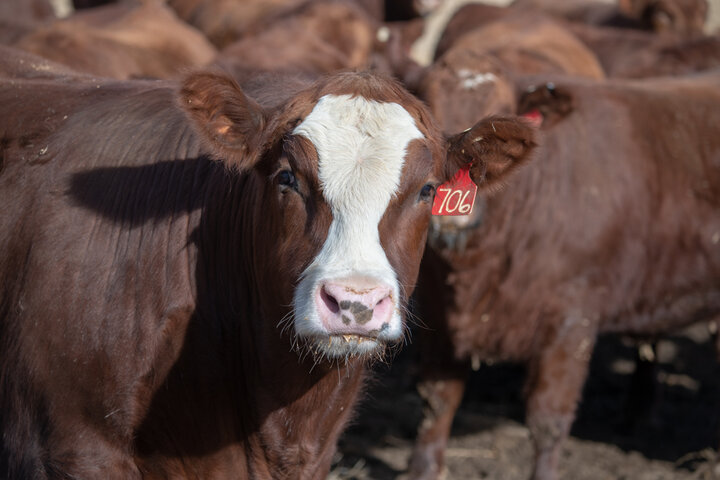Adverse winter weather can trim away pounds and increase costs of production up to 20% or more. Whether for feedlots or for wintering areas, proper holding pen design and maintenance are crucial to keeping cattle dry and comfortable under adverse climatic conditions.
In general, mud is one of our costliest weather hazards. The more you concentrate animals under wet conditions the slower pen surfaces dry, causing maintenance energy requirements to increase. In the summer, too much mud on cattle limits the ability of the animal to dissipate heat. Wet muddy areas, inside or outside of pens, are potential breeding areas for flies, which can exacerbate heat stress problems. In the winter, cattle maintenance requirements can be over 50% greater in pens containing wet, muddy cattle versus dry, clean cattle, causing reduced comfort and performance.
Summer-time is a good opportunity to get feedlot and other cattle holding pens prepared for next winter, especially if you had mud problems this year. This is accomplished by including mounds and/or good drainage in pen. Good lot drainage is critical to minimizing mud. The basic goal is to remove water as quickly as possible from the pen with minimum erosion of soil and manure. Mounds are useful for enhancing drainage in pens with very little slope and can also provide wind protection for cattle in the winter and allow for enhanced air-flow in the pen in the summer.
Mounds
If mounds are put in a pen it is easier to build mounds and shape pens as the first step when installing new lots. The cost is minimal at most locations if shaping is done before installing fencing, bunks, water troughs and aprons.
- In smaller pens, incorporate most of the lot in the mounds and valleys.
- Ideally a 3 to 5% slope (away from feedbunks) should be maintained in the pen, with the mound on the center-line of the pen, perpendicular to the high side of the pen and parallel to the direction of slope.
- Mounds should have valleys on both sides, with the valley running between the fence and the mound.
- Fence lines, which are parallel to the mounds, should also be elevated to allow all water to drain to the valleys and to the back of the pen.
- In old lots, mounds can be built from a mixture of manure and dirt.
- Locate the debris basins for collecting run-off outside the pen.
- Keep the back of the pen clean and open to allow pen drainage to discharge directly into debris basins.
- Most pen surfaces, including mounds, will need reshaping and soil added each year.
Concrete pads and aprons
Other aspects of feedlot design that should be considered for minimizing mud and enhancing cattle comfort is the construction of concrete pads or aprons (8 to 16 feet wide) along feed bunks and around water troughs. These structures eliminate much of the competition often associated with feeding areas when mud becomes a problem and good feeding spaces become scare. Mud tends to accumulate around feeding and watering places due to the soil being worked away while cattle are in these areas, leaving low spots, which accumulate moisture from normal precipitation events. Urine and fecal deposits also tend to be concentrated in these areas adding to the mud and moisture problems.
The bunk apron and the apron around the water trough should slope about 1/2 to 3/4 inch per foot away from the feed bunks and water trough. Ideally the water trough should be located about 20 to 30 feet from the back side of the fence-line feed bunk and lie near the center-line of the pen. Connecting the water trough apron to the bunk apron allows cattle to easily travel to and from mounds, water trough, and feed bunk.
Annual cleaning
Finally, it is essential that pens surfaces are cleaned annually, with any manure or undigested materials removed from the pen and firm hard-clay surfaces remain.
Undigested material, largely in the form of fiber, tends to have a high water holding capacity. These materials will significantly contribute to mud problems by not allowing the surface to dry as fast as they could, plus they may prevent water from running out of the pen.
Also, the amount and depth of mud in a feeding area is also dependent on the number of head or density of cattle in the area. A cow-calf pair, reared in drylot, can require over 750 square foot, while a feedlot animal normally requires about 1/3 this amount of space. However, under muddy conditions, space requirements can easily be doubled, depending on drying conditions and drainage.
Conclusion
Under Midwest climatic conditions, we rarely can eliminate the effects of adverse weather conditions, however we can minimize effects. Keeping livestock clean and dry will insure animal comfort and enhance returns. The design and maintenance of cattle holding and feeding areas play a crucial role in doing this.
Additional information on feedlot layout and design can be found in the UNL publication EC07-777 Planning a New Cattle Feedlot(PDF 8.5MB).

